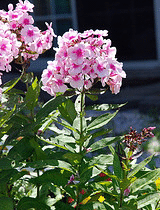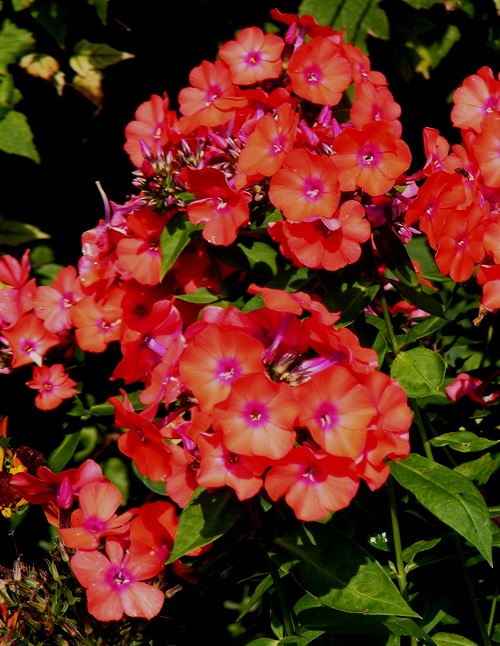Phlox
Garden Phlox are indispensable in the perennial garden, and there continues to be more color selection available all the time. New cultivars can be found from white, through pinks and purples, and on to reds and coral. Tall, leafed stems are topped with large clusters of showy flowers. Blooming is nonstop from summer through fall. Some varieties have a light fragrance.
Phlox grows and spreads easily, prefers good well drained soil in the sun, but doesn’t seem to mind poor soil or neglect too much. Tall garden Phlox does best in full sun, which helps to produce larger blooms and stronger stems. Garden Phlox will tolerate hot dry weather nicely, and light shade. Phlox is susceptible to powdery mildew so take care to water early in the day or with a drip method. Propagate by division in fall.
Phlox are not always easy to grow. They require a balance of moist soil but dry foliage. They like full sun but not too much heat and humidity will encourage powdery mildew. Generally the issues with growing Phlox do not, and should not, deter from including these cheerful bloomers in the garden. For some gardeners, a big plus is phlox’s tolerance to Black Walnut.
Phlox paniculata ‘Bright Eyes’
Common Name: Garden Phlox, Perennial Phlox, Summer Phlox
Plant Type: Herbaceous perennial
Height: 18-24”
Spread: 12-18”
Sun/Shade Requirements: Full sun preferred, to part shade
Water Requirements: Medium, does not tolerate drought
Soil Requirements: Moderately fertile soil, well drained and moist
Growth Habit: Tall, erect
Bloom Time: July through September
Bloom Color: Pale pink with deep magenta eyes
Bloom Form: Full rounded clusters of small flowers with five petals
Foliage: Full foliage with simple opposite leaves
Fragrance: Matured flowers are aromatic
Pest and Disease Resistance: Susceptible to powdery mildew. May be bothered by Phlox bugs and root rot.
Fertilize: Keep moderately fertilized by applying a time release fertilizer at a medium rate.
Maintenance: Deadhead spent flowers or cut for arrangements to encourage repeated, blooming. Plant well spaced to allow good air circulation and avoid powdery mildew. Sturdy stems will not normally need staking unless they grow exceptionally tall. Divide every few years to maintain good health. Discard woody centers.
Other: Attracts Birds, Butterflies and Hummingbirds
Hardiness: Zones 4 to 8
‘Bright Eyes’ is a great old fashioned phlox with soft pink blooms with deep magenta to red eyes. Individual blooms top long corolla tubes and are quite densely produced on very strong stems. Blooming begins in mid summer and continues through late summer. Blooming can be extended into fall if your cut the flowers for arrangements and/or remove spent blooms, which will encourage additional blooming and prevent self seeding. Strong sturdy stems and a light fragrance make ‘Bright Eyes’ and excellent flower for cut arrangements.
‘Bright Eyes’ is a vigorous old fashioned staple. Once established you will have ‘Bright Eyes’ in your garden for a very long time. It stands up well to a variety of soil conditions. ‘Bright Eyes’ has pretty good resistance to powdery mildew, but like all phlox will likely be afflicted from time to time.
The fragrant blooms will attract butterflies and hummingbirds. Like most garden phlox, ‘Bright Eyes’ prefers full sun and good air circulation to deter powdery mildew. Summer mulching will keep the roots cool. The plant will not tolerate drought, so water during dry periods with the drip method to discourage mildew.
Phlox paniculata ‘David’
Common Name: Garden Phlox, Perennial Phlox, Summer Phlox
Plant Type: Herbaceous perennial
Height: 24-36”
Spread: 24-36”
Sun/Shade Requirements: Full sun preferred, to part shade
Water Requirements: Medium, does not tolerate drought
Soil Requirements: Moderately fertile soil, well drained and moist. Will tolerate clay
Growth Habit: Tall, erect, bushy
Bloom Time: July through September
Bloom Color: Pure white
Bloom Form: Full rounded clusters of small flowers with five petals
Foliage: Full bright green foliage with simple opposite leaves
Fragrance: Matured flowers are aromatic
Pest and Disease Resistance: Susceptible to powdery mildew. May be bothered by Phlox bugs and root rot.
Fertilize: Keep moderately fertilized by applying a time release fertilizer at a medium rate.
Maintenance: Deadhead spent flowers or cut for arrangements to encourage repeated, blooming. Plant well spaced to allow good air circulation and avoid powdery mildew. Sturdy stems will not normally need staking unless they grow exceptionally tall. Divide every few years to maintain good health. Discard woody centers.
Other: Attracts Birds, Butterflies and Hummingbirds
Hardiness: Zones 3 to 8
‘David’ is a pure white perennial garden phlox with huge flowering clusters that are lightly fragrant. The bloom clusters are tightly packed in a pyramidal cluster. ‘David’ blooms from July through September, and reaches 2 - 4 feet tall and spreads 2 -3 feet. Remove spent blooms to encourage more bloom and discourage seeding. Cut flowers are very nice in an arrangement.
‘David’ requires average water and will not tolerate drought periods, but avoid overhead watering to deter mildew. It may attract butterflies and hummingbirds. The foliage is light green and has better mildew resistance than many phlox and is generally pest free. Mulch to keep the roots cool in summer. Prefers a rich, moist soil.
Phlox paniculata ‘Eve Callum’
Common Name: Garden Phlox, Perennial Phlox, Summer Phlox
Plant Type: Herbaceous perennial
Height: 24-36”
Spread: 24-36”
Sun/Shade Requirements: Full sun preferred, to part shade
Water Requirements: Medium, does not tolerate drought
Soil Requirements: Moderately fertile soil, well drained and moist
Growth Habit: Tall, erect
Bloom Time: July through September
Bloom Color: Pink with deep pink eyes
Bloom Form: Full rounded clusters of small flowers with five petals
Foliage: Full foliage with simple opposite leaves
Fragrance: Matured flowers are aromatic
Pest and Disease Resistance: Susceptible to powdery mildew. May be bothered by Phlox bugs and root rot.
Fertilize: Keep moderately fertilized by applying a time release fertilizer at a medium rate.
Maintenance: Deadhead spent flowers or cut for arrangements to encourage repeated, blooming. Plant well spaced to allow good air circulation and avoid powdery mildew. Sturdy stems will not normally need staking unless they grow exceptionally tall. Divide every few years to maintain good health. Discard woody centers.
Other: Attracts Birds, Butterflies and Hummingbirds
Hardiness: Zones 4 to 8
‘Eva Callum’ produces pink blooms with dark pink to red centers. The fragrant flowers are densely arranged on large pyramid shaped clusters. A long blooming season begins in midsummer through late summer. The bloom period may be extended into early fall by removing spent blooms, which will also discourage seeding. Or cut for arrangements to also encourage additional blooming, this is an excellent cut flower.
Flower stalks of ‘Eva Callum’ are sturdy and should not need staking unless exposed to strong winds. Generally ‘Eva Callum’s’ disease resistance is good, the plant is vigorous and extra hardy. Space well and keep the stalks thinned to discourage powdery mildew. Grow in rich moist soil in full sun to light shade, but this phlox will do best in full sun. ‘Eva Callum’ has been found to be hardy in zones 3, mulch heavily before winter.
Phlox paniculata ‘Star Fire’
Common Name: Garden Phlox, Perennial Phlox, Summer Phlox
Plant Type: Herbaceous perennial
Height: 24-36”
Spread: 18-24”
Sun/Shade Requirements: Full sun preferred, to part shade
Water Requirements: Medium, does not tolerate drought
Soil Requirements: Moderately fertile soil, well drained and moist
Growth Habit: Tall, erect
Bloom Time: July through September
Bloom Color: Deep red
Bloom Form: Full rounded clusters of small flowers with five petals
Foliage: Full foliage with simple opposite leaves
Fragrance: Matured flowers are aromatic
Pest and Disease Resistance: Susceptible to powdery mildew. May be bothered by Phlox bugs and root rot.
Fertilize: Keep moderately fertilized by applying a time release fertilizer at a medium rate.
Maintenance: Deadhead spent flowers or cut for arrangements to encourage repeated, blooming. Plant well spaced to allow good air circulation and avoid powdery mildew. Sturdy stems will not normally need staking unless they grow exceptionally tall. Divide every few years to maintain good health. Discard woody centers.
Other: Attracts Birds, Butterflies and Hummingbirds
Hardiness: Zones 4 to 8
The stunning red blooms of ‘Starfire’ are arranged in huge 6 to 12 inch pyramid clusters. Blooms are held on tall strong stems that should not need staking unless exposed to strong winds. The new foliage is striking with burgundy maroon tinged green that matures green.
‘Starfire’ is a standout phlox for rich coloring of bloom and foliage. The flower color is the truest red and is a vigorous strong plant. It is healthy and resilient. A tried and true garden phlox, ‘Starfire’ deserves a spot in your garden.



